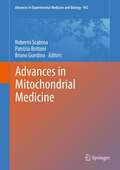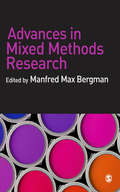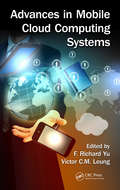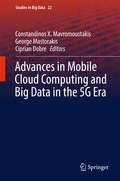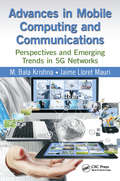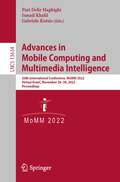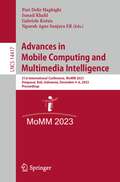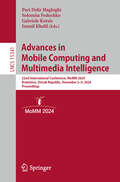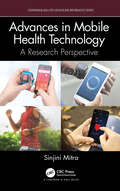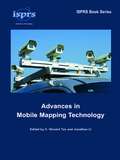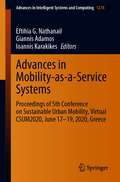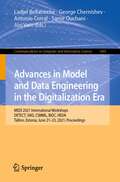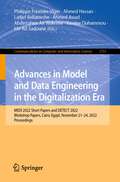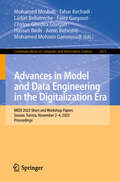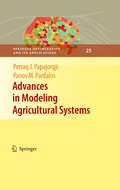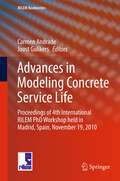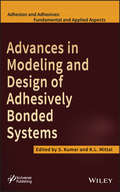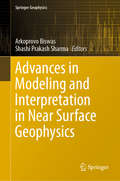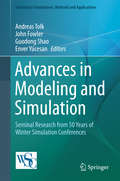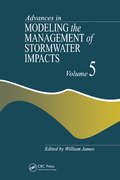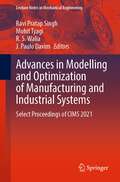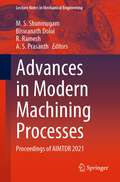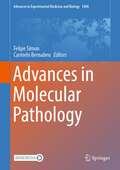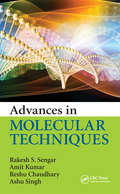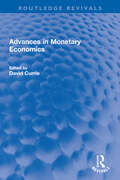- Table View
- List View
Advances in Mitochondrial Medicine (Advances in Experimental Medicine and Biology #942)
by Bruno Giardina Roberto Scatena Patrizia BottoniMitochondria are far more than the "powerhouse" of the cell as they have classically been described. In fact, mitochondria biological activities have progressively expanded to include not only various bioenergetic processes but also important biosynthetic pathways, calcium homeostasis and thermogenesis, cell death by apoptosis, several different signal transduction pathways mainly related to redox control of gene expression and so on. This functional and structural complexity may undergo important derangements so to justify the definition of 'mitochondrial medicine', which should include all the clinical consequences of congenital or acquired mitochondrial dysfunctions. There are actually a growing number of studies which assign a significant pathogenic role to damaged mitochondria in different diseases: ischemia/reperfusion injury, neurodegenerative diseases, cancer with its dramatic sequelae (i.e, metastasis), metabolic syndrome, hyperlipidemias, just to mention a few of the most important pathologies. In this context, a further aspect that should not be disregarded is the interaction of pharmacological agents with mitochondria, not only in regard of the toxicological aspects but, above all, of the potential therapeutic applications. In fact, it is interesting to note that, while the properties of different so-called "mitoxicants" are well-known, the subtle linkages between drugs and mitochondria is still in need of a real pharmacological and therapeutic control at the clinical level. This lack of consideration can often lead to an underestimation of unwanted toxic effects but also of desirable therapeutic activities. A reevaluation of the potential clinical role of mitochondria could give a new light on some yet obscure aspects of human pathophysiology.
Advances in Mixed Methods Research: Theories and Applications
by Manfred Max BergmanAdvances in Mixed Methods Research provides an essential introduction to the fast-growing field of mixed methods research. Bergman's book examines the current state of mixed-methods research, exploring exciting new ways of conceptualizing and conducting empirical research in the social and health sciences. Contributions from the world's leading experts in qualitative, quantitative, and mixed methods approaches are brought together, clearing the way for a more constructive approach to social research. These contributions cover the main practical and methodological issues and include a number of different visions of what mixed methods research is. The discussion also covers the use of mixed methods in a diverse range of fields, including sociology, education, politics, psychology, computational science and methodology. This book represents an important contribution to the ongoing debate surrounding the use of mixed methods in the social sciences and health research, and presents a convincing argument that the conventional, paradigmatic view of qualitative and quantitative research is outdated and in need of replacement. It will be essential reading for anyone actively engaged in qualitative, quantitative and mixed methods research and for students of social research methods. Manfred Max Bergman is Chair of Methodology and Political Sociology at the University of Basel.
Advances in Mobile Cloud Computing Systems
by F. Richard Yu Victor C.M. LeungWith recent advances in mobile communication technologies, more and more people are accessing cloud computing systems using mobile devices, such as smartphones and tablets. Unlike traditional mobile computing systems with limited capabilities, mobile cloud computing uses the powerful computing and storage resources available in the cloud to provide
Advances in Mobile Cloud Computing and Big Data in the 5G Era (Studies in Big Data #22)
by Constandinos X. Mavromoustakis George Mastorakis Ciprian DobreThis book reports on the latest advances on the theories, practices, standards and strategies that are related to the modern technology paradigms, the Mobile Cloud computing (MCC) and Big Data, as the pillars and their association with the emerging 5G mobile networks. The book includes 15 rigorously refereed chapters written by leading international researchers, providing the readers with technical and scientific information about various aspects of Big Data and Mobile Cloud Computing, from basic concepts to advanced findings, reporting the state-of-the-art on Big Data management. It demonstrates and discusses methods and practices to improve multi-source Big Data manipulation techniques, as well as the integration of resources availability through the 3As (Anywhere, Anything, Anytime) paradigm, using the 5G access technologies.
Advances in Mobile Computing and Communications: Perspectives and Emerging Trends in 5G Networks
by M. Bala Krishna Jaime Lloret MauriBy 2020, if not before, mobile computing and wireless systems are expected to enter the fifth generation (5G), which promises evolutionary if not revolutionary services. What those advanced services will look like, sound like, and feel like is the theme of the book Advances in Mobile Computing and Communications: Perspectives and Emerging Trends in 5G Networks. The book explores futuristic and compelling ideas in latest developments of communication and networking aspects of 5G. As such, it serves as an excellent guide for advanced developers, communication network scientists, researchers, academicians, and graduate students. The authors address computing models, communication architecture, and protocols based on 3G, LTE, LTE-A, 4G, and beyond. Topics include advances in 4G, radio propagation and channel modeling aspects of 4G networks, limited feedback for 4G, and game theory application for power control and subcarrier allocation in OFDMA cellular networks. Additionally, the book covers millimeter-wave technology for 5G networks, multicellular heterogeneous networks, and energy-efficient mobile wireless network operations for 4G and beyond using HetNets. Finally, the authors delve into opportunistic multiconnect networks with P2P WiFi and cellular providers and video streaming over wireless channels for 4G and beyond.
Advances in Mobile Computing and Multimedia Intelligence: 20th International Conference, MoMM 2022, Virtual Event, November 28–30, 2022, Proceedings (Lecture Notes in Computer Science #13634)
by Ismail Khalil Gabriele Kotsis Pari Delir HaghighiThis volume includes the papers presented at the 20th International Conference on Advances in Mobile Computing & Multimedia Intelligence (MoMM2022), organized in conjunction with 24th International Conference on Information Integration and Web Intelligence. The dominant research focus of submitted papers was artificial intelligence and machine learning. The accepted papers presented advances and innovations in an array of areas such as online teaching, activity and movement detection, greenhouse gas emission, smart irrigation, network security, and video delivery. MoMM2022 attracted 34 papers, from which the Program Committee selected 8 regular papers and 8 short papers.Due to safety concerns as well as other restrictions preventing travel and gatherings, it was decided to organize MoMM2022 as a virtual conference.
Advances in Mobile Computing and Multimedia Intelligence: 21st International Conference, MoMM 2023, Denpasar, Bali, Indonesia, December 4–6, 2023, Proceedings (Lecture Notes in Computer Science #14417)
by Ismail Khalil Gabriele Kotsis Pari Delir Haghighi Ngurah Agus Sanjaya ERThis book constitutes the refereed proceedings of the 21st International Conference on Advances in Mobile Computing and Multimedia Intelligence, MoMM2023, organized in conjunction with the 25th International Conference on Information Integration and Web Intelligence, iiWAS 2023, held in Denpasar, Bali, Indonesia, during December 4-6, 2023.The 10 full papers and 5 short papers presented in this book were carefully reviewed and selected from 37 submissions. The papers are divided into the following topical sections: security in mobile environments; mobile computing and wireless sensors; and image and video processing.
Advances in Mobile Computing and Multimedia Intelligence: 22nd International Conference, MoMM 2024, Bratislava, Slovak Republic, December 2–4, 2024, Proceedings (Lecture Notes in Computer Science #15341)
by Ismail Khalil Gabriele Kotsis Pari Delir Haghighi Solomiia FedushkoThis book constitutes the refereed proceedings of the 22nd International Conference on Advances in Mobile Computing and Multimedia Intelligence, MoMM 2024, held in Bratislava, Slovak Republic, during December 2–4, 2024. The 10 full papers and 8 short papers in this book were carefully reviewed and selected from 34 submissions. They were organized in topical sections as follows: wearable and sensor-based data for human performance and interaction; mobile user experience, motivation, and behavior; medical and cognitive health applications; image, video, and multimedia processing; software and system intelligence.
Advances in Mobile Health Technology: A Research Perspective (Chapman & Hall/CRC Healthcare Informatics Series)
by Sinjini MitraThe COVID-19 pandemic upended the lives of many and taught us the critical importance of taking care of one’s health and wellness. Technological advances, coupled with advances in healthcare, has enabled the widespread growth of a new area called mobile health or mHealth that has completely revolutionized how people envision healthcare today. Just as smartphones and tablet computers are rapidly becoming the dominant consumer computer platforms, mHealth technology is emerging as an integral part of consumer health and wellness management regimes. The aim of this book is to inform readers about the this relatively modern technology, from its history and evolution to the current state-of-the-art research developments and the underlying challenges related to privacy and security issues. The book’s intended audience includes individuals interested in learning about mHealth and its contemporary applications, from students to researchers and practitioners working in this field. Both undergraduate and graduate students enrolled in college-level healthcare courses will find this book to be an especially useful companion and will be able to discover and explore novel research directions that will further enrich the field.
Advances in Mobile Mapping Technology (Isprs Book Ser. #4)
by Jonathan Li C. Vincent TaoThe growing market penetration of Internet mapping, satellite imaging and personal navigation has opened up great research and business opportunities to geospatial communities. Multi-platform and multi-sensor integrated mapping technology has clearly established a trend towards fast geospatial data acquisition. Sensors can be mounted on various pla
Advances in Mobility-as-a-Service Systems: Proceedings of 5th Conference on Sustainable Urban Mobility, Virtual CSUM2020, June 17-19, 2020, Greece (Advances in Intelligent Systems and Computing #1278)
by Eftihia G. Nathanail Giannis Adamos Ioannis KarakikesThis book gathers together innovative research and practical findings relating to urban mobility transformation. It is especially intended to provide academicians, researchers, practitioners and decision makers with effective strategies and techniques that can support urban mobility in a sustainable way. The chapters, which report on contributions presented at the 5th Conference on Sustainable Urban Mobility, held virtually on June 17-19, 2020, from Greece, cover the thematic areas of: social networks and traveler behavior; applications of technologies in transportation and big data analytics; transport infrastructure and traffic management; and transportation modeling and impact assessment. Special attention is given to public transport and demand responsive systems, electromobility, micromobility and automated vehicles. The book addresses the challenges of the near future, highlighting the importance of knowledge transfer, and it is intended to foster communication among universities, industries and public administration.
Advances in Model and Data Engineering in the Digitalization Era: MEDI 2021 International Workshops: DETECT, SIAS, CSMML, BIOC, HEDA, Tallinn, Estonia, June 21–23, 2021, Proceedings (Communications in Computer and Information Science #1481)
by Ladjel Bellatreche George Chernishev Antonio Corral Samir Ouchani Jüri VainThis book constitutes the thoroughly refereed papers of the workshops held at the 10th International Conference on New Trends in Model and Data Engineering, MEDI 2021, held in Tallinn, Estonia, in June 2021: Workshop on moDeling, vErification and Testing of dEpendable CriTical systems, DETECT 2021; Symposium on Intelligent and Autonomous Systems, SIAS 2021; Worjshop on Control Software: Methods, Models, and Languages, CSMML 2021; Blockchain for Inter-Organizational Collaboration, BIOC 2021; The International Health Data Workshop, HEDA 2021.The 20 full and the 4 short workshop papers presented were carefully reviewed and selected from 61 submissions. The papers are organized according to the workshops: Workshop on moDeling, vErification and Testing of dEpendable CriTical systems, DETECT 2021; Symposium on Intelligent and Autonomous Systems, SIAS 2021; Worjshop on Control Software: Methods, Models, and Languages, CSMML 2021; Blockchain for Inter-Organizational Collaboration, BIOC 2021; The International Health Data Workshop, HEDA 2021.
Advances in Model and Data Engineering in the Digitalization Era: MEDI 2022 Short Papers and DETECT 2022 Workshop Papers, Cairo, Egypt, November 21–24, 2022, Proceedings (Communications in Computer and Information Science #1751)
by Ladjel Bellatreche Ahmed Awad Yassine Ouhammou Philippe Fournier-Viger Ahmed Hassan Abderrahim Ait Wakrime Idir Ait SadouneThis volume constitutes short papers and DETECT 2022 workshop papers, presented during the 11th International Conference on Model and Data Engineering, MEDI 2022, held in Cairo, Egypt, in November 2022.The 11 short papers presented were selected from the total of 65 submissions. This volume also contains the 4 accepted papers from the DETECT 2022 workshop, held at MEDI 2022. The volume focuses on advances in data management and modelling, including topics such as data models, data processing, database theory, database systems technology, and advanced database applications.
Advances in Model and Data Engineering in the Digitalization Era: MEDI 2023 Short and Workshop Papers, Sousse, Tunisia, November 2–4, 2023, Proceedings (Communications in Computer and Information Science #2071)
by Faiez Gargouri Ladjel Bellatreche Amin Beheshti Mohamed Mosbah Tahar Kechadi Hassan Badir Chirine Ghedira Guegan Mohamed Mohsen GammoudiThis volume constitutes short papers and DEITS 2023 workshop papers, presented during the 12th International Conference on Model and Data Engineering, MEDI 2023, held in Sousse, Tunisia, in November 2023.The 12 short papers presented were selected from the total of 99 submissions. This volume also contains the 7 accepted papers from the DEITS 2023 workshop, held at MEDI 2023. The volume focuses on machine learning and optimization; natural language processing; modeling and data management; healthcare applications; data engineering in IoT systems.
Advances in Modeling Agricultural Systems (Springer Optimization and Its Applications #25)
by Panos M. Pardalos Petraq PapajorgjiThis book presents an up-to-date review of advances in the mathematical modeling of agricultural systems. It covers a broad spectrum of problems and applications based on internet and communications technology, as well as methodological approaches based on the integration of different simulation and data management tools. Using real-world cases, each chapter presents a detailed solution of a problem in a particular field. This book demonstrates that regardless of the nature of the problem and the application domain, modeling is a central and important activity in the process of developing agricultural systems. Researchers and graduate students in the fields of agriculture and environmental studies will benefit from this book. It will also serve as an excellent reference for managers, team leaders, developers and modelers of agricultural and environmental systems and researchers in the applied computation field.
Advances in Modeling Concrete Service Life: Proceedings of 4th International RILEM PhD Workshop held in Madrid, Spain, November19, 2010 (RILEM Bookseries #3)
by Carmen Andrade Joost GulikersIn this book, a critical analysis is made on service life models related to reinforcement corrosion. The contributors are on the frontier of knowledge in the field of durability of reinforced concrete. Topics covered in the book include: causes and mechanisms of deterioration, transport mechanisms in concrete, numerical modeling of concrete behavior, durability modeling and prediction, reliability approach to structural design for durability, structural behavior following degradation of concrete structures, deterioration and repair of concrete structures, and corrosion measurement techniques.
Advances in Modeling and Design of Adhesively Bonded Systems
by K. L. Mittal S. KumarThe book comprehensively charts a way for industry to employ adhesively bonded joints to make systems more efficient and cost-effectiveAdhesively bonded systems have found applications in a wide spectrum of industries (e.g., aerospace, electronics, construction, ship building, biomedical, etc.) for a variety of purposes. Emerging adhesive materials with improved mechanical properties have allowed adhesion strength approaching that of the bonded materials themselves. Due to advances in adhesive materials and the many potential merits that adhesive bonding offers, adhesive bonding has replaced other joining methods in many applications.Containing nine articles written by world-renowned experts, the book deals with the advances in theoretical and computational modeling as well as the design and experimental aspects of adhesively bonded structural systems. Stress analysis and strength prediction of adhesively bonded structural systems, considering a range of material models under a variety of loading conditions, are discussed. Finite element modeling using macro-elements is elaborated on. Recent developments in modeling and experimental aspects of bonded systems with graded adhesive layers and dual adhesives are described. Simulation of progressive damage in bonded joints is addressed. A novel vibration-based approach to detect disbonding and delamination in composite joints is also discussed.ReadershipThe book is central to a range of engineers including mechanical, reliability, construction and surface engineers as well as materials scientists who are engaged in the mechanics of structural adhesive joints. Industries that will use this book include aerospace, electronics, biomedical, automotive, ship building, and construction.
Advances in Modeling and Interpretation in Near Surface Geophysics (Springer Geophysics)
by Arkoprovo Biswas Shashi Prakash SharmaThis book deals primarily with the aspects of advances in near surface geophysical data modeling, different interpretation techniques, new ideas and an integrated study to delineate the subsurface structures. It also involves the practical application of different geophysical methods to delineate the subsurface structures associated with mineral, groundwater exploration, subsurface contamination, hot springs, coal fire etc. This book is specifically aimed with the state-of-art information regarding research advances and new developments in these areas of study, coupled to extensive modeling and field investigations obtained from around the world. It is extremely enlightening for the research workers, scientists, faculty members and students, in Applied Geophysics, Near Surface Geophysics, Potential Field, Electrical and Electromagnetic Methods, Mathematical Modeling Techniques in Earth Sciences, as well as Environmental Geophysics.
Advances in Modeling and Simulation: Seminal Research from 50 Years of Winter Simulation Conferences (Simulation Foundations, Methods and Applications)
by Andreas Tolk John Fowler Guodong Shao Enver YücesanThis broad-ranging text/reference presents a fascinating review of the state of the art of modeling and simulation, highlighting both the seminal work of preeminent authorities and exciting developments from promising young researchers in the field. Celebrating the 50th anniversary of the Winter Simulation Conference (WSC), the premier international forum for disseminating recent advances in the field of system simulation, the book showcases the historical importance of this influential conference while also looking forward to a bright future for the simulation community. Topics and features: examines the challenge of constructing valid and efficient models, emphasizing the benefits of the process of simulation modeling; discusses model calibration, input model risk, and approaches to validating emergent behaviors in large-scale complex systems with non-linear interactions; reviews the evolution of simulation languages, and the history of the Time Warp algorithm; offers a focus on the design and analysis of simulation experiments under various goals, and describes how data can be "farmed" to support decision making; provides a comprehensive overview of Bayesian belief models for simulation-based decision making, and introduces a model for ranking and selection in cloud computing; highlights how input model uncertainty impacts simulation optimization, and proposes an approach to quantify and control the impact of input model risk; surveys the applications of simulation in semiconductor manufacturing, in social and behavioral modeling, and in military planning and training; presents data analysis on the publications from the Winter Simulation Conference, offering a big-data perspective on the significant impact of the conference. This informative and inspiring volume will appeal to all academics and professionals interested in computational and mathematical modeling and simulation, as well as to graduate students on the path to form the next generation of WSC pioneers.
Advances in Modeling the Management of Stormwater Impacts
by William JamesThe latest book in the popular series demonstrates state-of-the-art methods, models, and techniques for water quality management. This book includes a CD-ROM that collects hundreds of hard-to-find literature citations from the gray literature.
Advances in Modelling and Optimization of Manufacturing and Industrial Systems: Select Proceedings of CIMS 2021 (Lecture Notes in Mechanical Engineering)
by J. Paulo Davim Mohit Tyagi Ravi Pratap Singh R. S. WaliaThis book presents select proceedings of the 2nd International Conference on Industrial and Manufacturing Systems (CIMS 2021) and discusses the applications of soft computing, modelling and optimization practices in industrial and manufacturing systems. Various topics covered in this book include advanced machining methods and performances, industrial operations, processing with hybrid manufacturing techniques, fabrication and developments in micro-machining and its applications, practical issues in supply chain, micro-structure analysis, additive manufacturing processes, reliability and system analysis, material science and metallurgical behaviour analysis, product design and development, etc. The book will be a valuable reference for beginners, researchers, and professionals interested in the modelling, optimization and soft computing related aspects of industrial and production engineering and its allied domains.
Advances in Modern Machining Processes: Proceedings of AIMTDR 2021 (Lecture Notes in Mechanical Engineering)
by M. S. Shunmugam R. Ramesh Biswanath Doloi A. S. PrasanthThe book presents select proceedings of the 8th International and 29th All India Manufacturing Technology, Design and Research (AIMTDR 2021) conference. It covers recent advances in the realms of electro- physical and chemical machining, machining optimization, surface morphology and sustainable machining. The contents also include precision engineering, metrology and quality, automation and smart systems, enterprise manufacturing intelligence, among others. This book will evoke interest among academicians, researchers, and practicing engineers who aspire to comprehend advances pertaining to the domain of modern machining processes
Advances in Molecular Pathology (Advances in Experimental Medicine and Biology #1408)
by Felipe Simon Carmelo BernabeuThe present work corresponds to a compilation of independent contributions in the fields of endocrinology, immunity, cancer, neurobiology, and myology. Revision of current advances as well as novel findings in the form of original articles are presented in a balanced fashion. The book has been divided into three sections in line with the main subject: Molecular pathology of immune, inflammatory, and hemostatic disorders; Molecular pathology of endocrine and muscular disorders; and Molecular pathology of cancer: determinants and potential therapies. In the first section, contributing authors take the reader through the molecular pathology of immune responses, inflammation, and hemostasis, by collating an update on systemic autoimmune diseases, the therapeutic potential of statins in hemostasis, the effects of adrenergic stimulation on coagulation, the emerging field of physical burnout due to the mobility restrictions in response to the 2020 SARS-CoV-2 pandemic imposed worldwide, and the success of community-oriented muscular kinesic rehabilitation. The second section presents engaging results from a survey of iodine intake through the diet of pregnant females, an appraisal of the neuroprotective effect of dexmedetomidine, novel evidence on muscle physiopathology, describing the upregulation of CCL5/RANTES during cholestatic liver disease, the fibrotic response emerging in response to cholic and deoxycholic acids, and the altering effects of bile acids in autophagy and mitogenesis. In the third section, a comprehensive revision of cancer literature is offered with an emphasis on melanoma, myeloid-derived suppressor cells, microRNA-based diagnostic approaches, and new avenues for cancer immunotherapy. Altogether, these individual contributions offer a comprehensive and up-to-date outlook of the current state in the field of molecular pathology.Chapter 14 is available open access under a Creative Commons Attribution 4.0 International License via link.springer.com.
Advances in Molecular Techniques
by Amit Kumar Ashu Singh Rakesh S. Sengar Reshu ChaudharyMolecular genetics aims to comprehend biological activity at the gene sub-level. Scientists from different areas of research and applied science can use the standard techniques optimized by molecular biologists.This book serves as a guide that introduces classic molecular biology techniques and advances in molecular and genetic engineering.
Advances in Monetary Economics (Routledge Revivals)
by David CurrieFirst published in 1985, Advances in Monetary Economics draws together papers given at the 1984 Money Study Group Conference and additional papers presented in seminars of the same year. The book includes papers on theoretical, empirical and institutional aspects of monetary economics. Each chapter displays a concern with policy in the monetary sphere, both with regards to macroeconomic questions of monetary and fiscal management, and issues of policy at the microeconomic level towards financial institutions and markets. In doing so, the book highlights the importance of monetary economics in policy issues. Advances in Monetary Economics has enduring relevance for those with an interest in the history and development of monetary economics.
